Automating Marketing Processes with Budibase
Automating marketing processes is a top priority for modern businesses. The more money you can save on acquiring new customers, the more profitable just about every other business activity will be.
The problem is that a lot of marketing pros get a bit squeamish here.
After all, marketers are typically creative types. So, you might think automation is beyond your reach, either in terms of resources or know-how.
For the most part, this just isn’t the case. At least not these days.
Instead, there are countless different platforms, tools, and systems that make it easier than ever for marketers to automate their processes.
Today, we’re going to cover everything you need to know about automating marketing processes, including the specific tools you can use, the kinds of processes you can target, and the results you can expect.
We’ll also see some practical examples of how Budibase is making it easier than ever to build robust, automated marketing processes.
As ever though, let’s start with the basics.
What is marketing process automation?
Marketing process automation is all about using digital transformation to eliminate manual tasks that eat up your team’s time and other resources.
The idea is to replace human interactions with automated processes to boost efficiency, transparency, and cost-effectiveness.
This can take a few different forms.
There’s a big difference, for example, between a simple automated taxonomy for your lead generation form, and a more complex end-to-end system for managing e-commerce users.
That is, there’s a clear difference in the scale, sophistication, and goals of these two examples.
As such, we’ll need to take a step back.
What is a marketing process?
We need a clearer idea of what a marketing process actually is. This isn’t as obvious as it might seem at first glance.
When we talk about processes, we mean something a little bit more specific than just whatever your marketing team gets up to during the working day.
Rather, a process is a defined set of tasks that need to be completed to achieve a specific goal.
There are a couple of key things to unpack here. Firstly, there are the constituent tasks that make up your process. Then there’s the structure that these follow and the logic that underpins them.
Finally, we have the decisions that need to be made about how each constituent task is performed. In other words, what happens at each step along the way.
Processes vary in terms of depth and scale.
So, we can essentially think about a process in terms of the number of actions that it contains and the complexity of each decision along the way. Then we have the number of customers, leads, or internal users that are involved, along with how often the process is initiated.
Check out our ultimate guide to business process automation for a more detailed explanation.
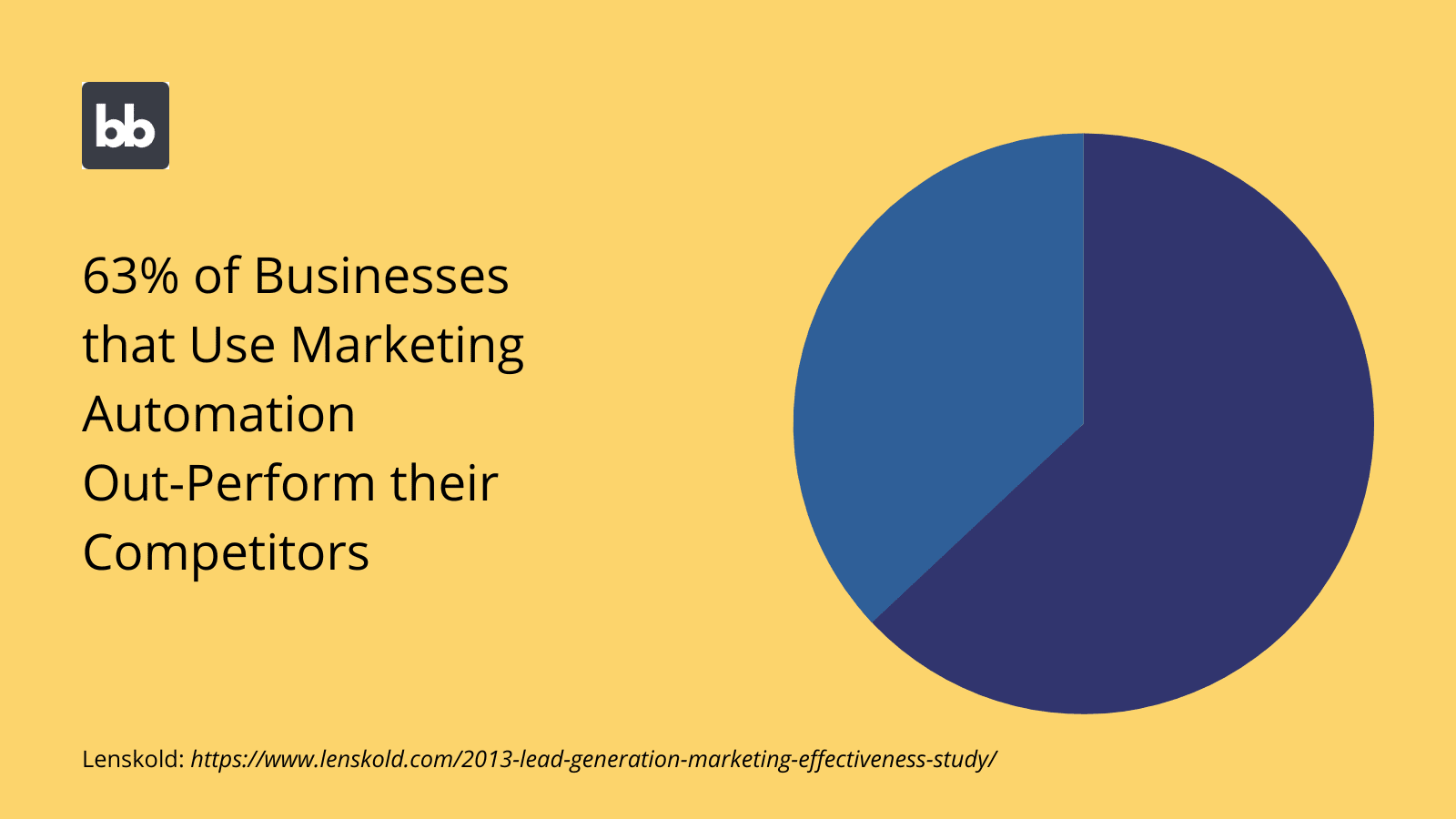
Why automate marketing processes?
Again, there’s more to this than you might think. Should you automate processes just because you can or because the marketing departments from your SaaS platforms think you should?
Frankly, these probably aren’t the right reasons.
Later, we’re going to talk about how you can set goals for automating marketing processes. To get a bit of background, it’s important to know the benefits on offer first.
Here we go.
Efficiency
Efficiency is a measure of the time and resources required to complete a process. More accurately, this is an inverse relationship. So, your processes are more efficient when they’re faster and less resource-intensive.
Hopefully, we don’t need to explain what time is, so let’s focus on what we mean by resources.
For the most part, this is labor costs.
That is, the time your team needs to spend on different tasks. This includes direct costs, like salaries, as well as the opportunity costs of more profitable work your employees could be working on instead.
Check out our guide on how to automate tasks to find out more.
Of course, other resources come into achieving your marketing goals. These obviously vary from channel to channel. For example, you could have the cost-per-click in a PPC campaign or licensing dedicated tools for your email marketing.
Some of these, like platform licenses, are essentially fixed. Automation can’t help you reduce them, but it will help you get more bang for your buck.
Let’s take a look at how.
Conversion rate optimization
Conversion rate optimization (CRO) is a set of techniques and strategies that aim to maximize the proportion of users who take your desired action. In other words, CRO is all about increasing the ratio of conversions to users.
Automation plays a key role here.
For example, we could leverage a variety of automations in a lead generation form. We could route responses to different tools, campaigns, and teams, depending on the information provided.
Or, we could use specific attributes to tailor and personalize messaging.
Alternatively, we could flip this formula around.
Remember, one of the key goals of automation is to reduce the manual actions that users need to take to complete specific tasks.
This is a huge opportunity. One of the fundamental truths of marketing is that people are lazy.
The less you expect your users to do, the more likely they are to convert. For instance, we could create an automation for one-click account creation, based on information users provide elsewhere, like a checkout form.
Lifetime customer values
Lifetime value (LTV) is the total amount of revenue that an average customer generates, from their first purchase to their last. It’s basically a function of three things:
- The amount customers typically spend per transaction.
- The frequency of transactions.
- How long you retain customers.
So, if you run a monthly subscription service, your LTV would essentially be the rate customers pay multiplied by how long they subscribe.
Automation can be used to improve each of these factors.
In terms of average order values, you have a couple of key levers to pull. One is upselling related products and services, or even personalized recommendations based on previous behavior.
Another would be targeting products at different price points to different leads, based on the information you already know about them. So, in a B2B setting, you’d target higher-value packages to leads when you know they exceed a certain employee count.
In terms of transaction frequency and retention rates, there are countless automation strategies out there.
For instance, email campaigns based on product releases, offers, or time-based triggers.
Personalization
Personalizing experiences for your users, leads, and customers is a powerful way to boost conversions and increase retention.
This means tailoring experiences to individual users, based on the information you already know about them. This could be any number of attributes.
The most basic option would be using names or other personal details within your marketing messaging. This might sound straightforward enough, but it actually necessitates at least some degree of automation.
Unless you want to handwrite every email, that is.
Instead, you need an automation platform of some kind to bind your desired attributes to different fields within your messaging.
Of course, there are more advanced use cases for personalization too.
For instance, leveraging their previous transactions, known preferences, or location and demographic information.
Consistency, transparency, & accountability
One less obvious benefit of automating marketing processes is improving consistency, transparency, and accountability across your team.
Automating processes means limiting the manul actions that users can take at any given time.
Another way to think about this is that you’re creating a systematic approach and removing discretion from individual employees within processes.
This is critical, especially in large organizations.
We’ve all seen what happens when a rogue employee takes to Twitter and goes off message.
Automation doesn’t just apply to creative processes or the channels you use to reach customers. Rather, it also plays a huge role in how you structure and manage your internal team.
For example, content approval workflows, resource requests, and storing approved assets.
Security and compliance
There’s no getting around the fact that marketing departments store and process a huge amount of personal information. This means that there’s an outsized risk of data breaches or other compliance issues.
The role of automation can’t be oversold here.
One element of this is that automating marketing processes limits your team’s exposure to data. For example, in an automated PPC or email tool, your team doesn’t necessarily need to be able to see every lead’s details to bind key attributes.
Automation also ensures that you can more strictly control the actions that users can take. For example, if you build a single automated process for updating customer information, it’s much easier to control who can initiate this and how.
What kinds of marketing processes can be automated
Next, let’s think about the specific kinds of marketing processes that we might want to automate.
There are a few different categories of processes that we can think about here. We’ve already hinted at this to some extent.
For now, we’ll think about four different kinds of processes:
- Creative processes - Such as deciding on messaging or creating assets.
- Strategic processes - Including deciding what campaigns to focus on and how to allocate resources.
- Operations processes - Internal tasks like scheduling training or requests and approvals.
- Delivery processes - Actually getting your messaging in front of customers.
We’ll look at some examples of each in a second.
The key thing to understand first is that automation can touch on any of these, but the specific tools and techniques you’ll use might vary across them. So will your goals.
Let’s explore some of the most common marketing automation use cases to see how this works in practice.
Top 8 marketing processes to automate
We can look to the most widely automated processes for a better idea of where the biggest opportunities lie.
1. Email marketing
Email marketing is probably the first thing you think of when you hear the words marketing automation. Really, there is no email marketing without automation. As we know, the more detail you hold within your contact lists, the more sophisticated your campaigns can be.
Automation is your pathway to leveraging this data.
Email automation essentially works by using defined triggers to send out pre-built messages.
More specifically, there are three elements to keep abreast of:
- Triggers - The conditions that decide when an email should be sent.
- Templates - The main body of your emails which is common to all recipients.
- Bindable values - The specific user or other attributes that fill in specific details within templates.
We can distinguish between two different kinds of email automation. The first is email marketing as a discrete channel. The other is using automated emails as part of some other marketing process.
The first type normally means using a dedicated tool, like MailChimp.
The second kind is using automated emails as part of other marketing activities, for instance in a check-out process.
2. Lead generation
Lead generation is a little bit of a less obvious case for automation. The goal here is to get people into your marketing funnels in the first place. There are a few different ways that you can go about this.
It depends on how sophisticated your lead gen efforts are.
So, you might have a simple sign-up form to secure leads and then use a chain of automated emails after this.
We can use automation to add more personalization and tailor our approach to different users. Alternatively, we might only use automation to manage the data we gather through our sign-up forms.
An example of the first would be using user-provided data to determine the specific flow of emails they receive. For example, in a B2B setting, we’d normally ask users for their job titles or the department they work in.
Or, we might simply use automation to move our leads’ data from the sign-up tool to other platforms.
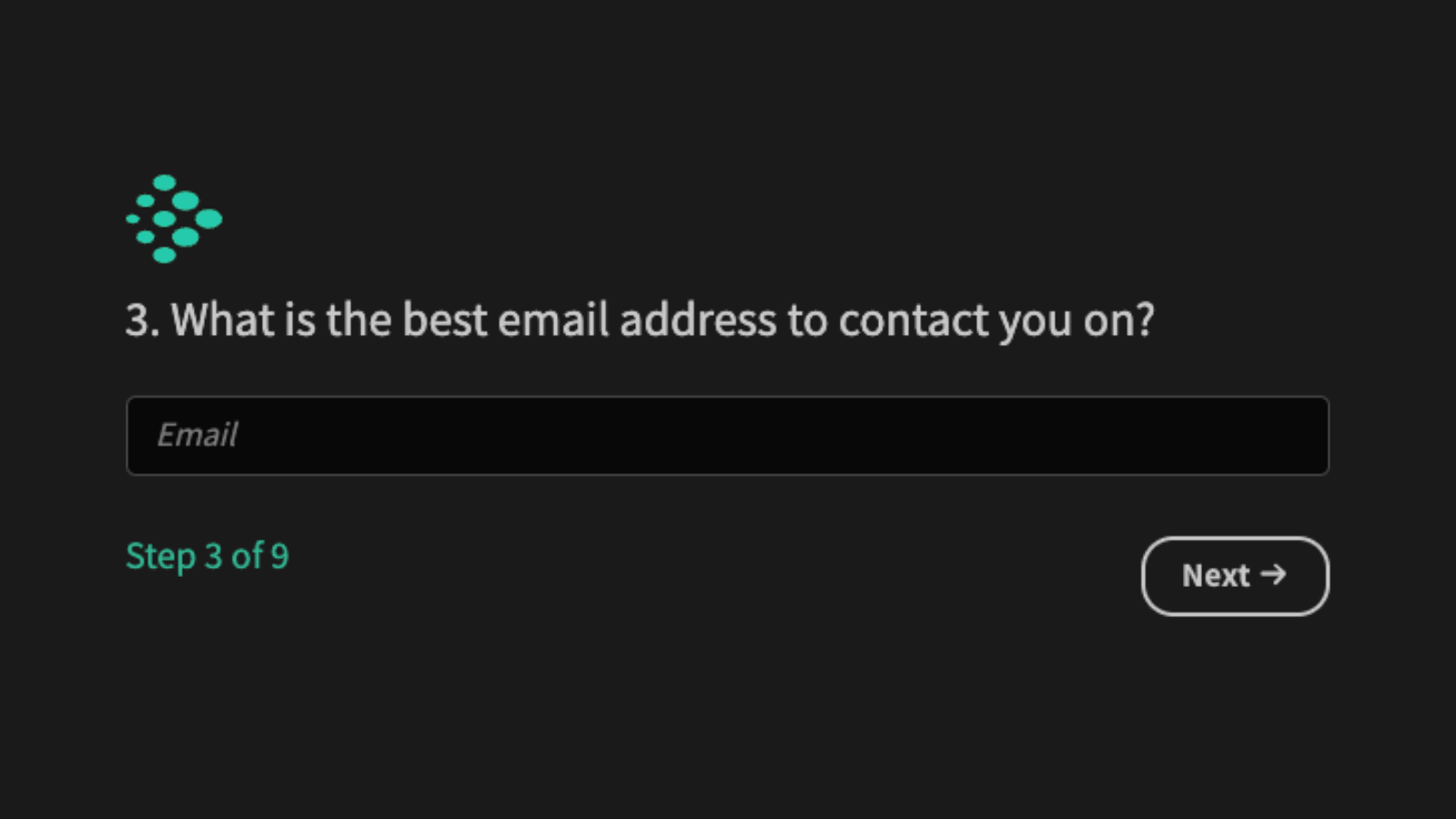
3. Lead qualification
Lead qualification involves a couple of things:
- Figuring out how close a lead is to making a purchase.
- Deciding the resources that will lead them to convert.
This is a crucial but often overlooked step.
We need lead qualification to decide if a potential customer is worth pursuing and what approach to take if so.
As we saw already, this could mean assigning leads to different teams based on the data they provide.
Or, we could take a slightly different approach.
Specifically, we might want to use automation to track our leads as they move towards making a process. One way to do this would be to monitor how they interact with our campaigns.
For example, if a lead opens a set number of emails in a particular period, this could trigger an automation that passes their details onto our sales team to try and schedule a call.
4. Reporting and analysis
Campaign reporting and analysis is vital, but it can also eat up a lot of your team’s time. As such, it’s a great candidate for process automation. There are several specific tasks here that can be effectively automated.
One is simply consolidating the data you need to measure your success.
Think how much time you could save if your team didn’t need to manually collate all the different values you need to report on your campaigns’ performance. One solution here is building real-time dashboards.
We can also use automations to perform specific analytical tasks.
For instance, we could build a custom dashboard to perform calculations on different attributes in real time. That way, our team doesn’t need to do this manually.
Similarly, we can automate marketing processes around sharing insights.
This could be as simple as creating and scheduling internal communications around your progress towards different goals.
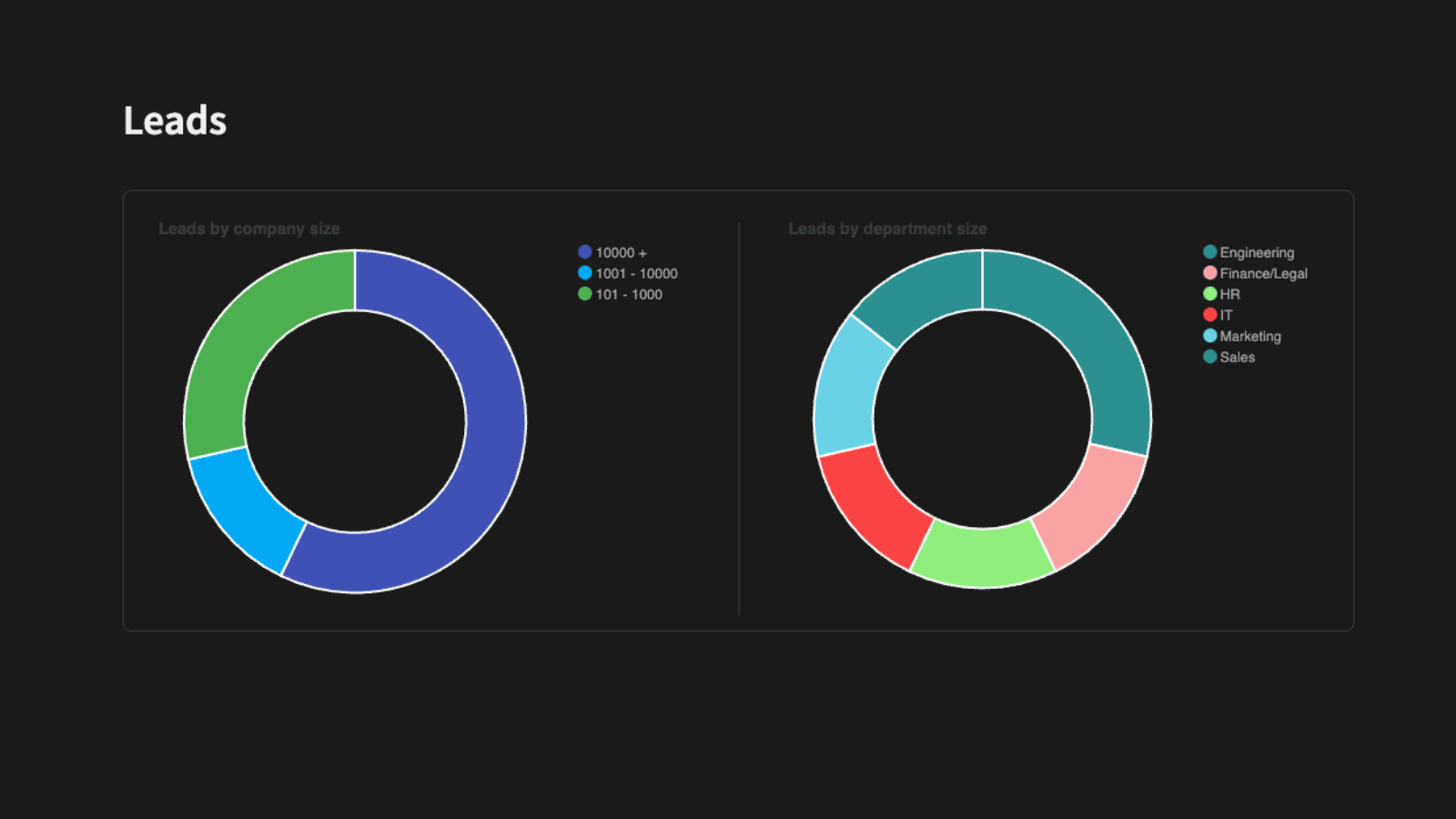
5. Relationship management
Managing customer relationships is another time-consuming and expensive marketing process.
The real challenge here is that customer interactions are hard to predict compared to other marketing processes. That is, customers often have unique challenges, experiences, and queries.
A human touch is critical here, as inappropriate automations lead to terrible customer experiences.
So, what we need to do is decide where automation is the right approach and where we need to retain our manual interactions. In other words, we want to use automation where we can, to free our customer service team up for the situation where they’re needed.
One option would be creating automated self-service portals, allowing customers to carry out basic actions without the need to contact your team.
Or, we could even automate basic interactions. For example, by using chatbots. That way, simple, repetitive customer queries can be taken care of almost instantly, so your team can focus on more challenging fringe cases.
6. Campaign management
Campaign management processes present a huge amount of variation. We can think about this at a couple of different levels:
- Variations between different types of campaigns.
- Variations in the specific details within a single type of campaign.
- Variations on the kinds of tasks employees perform within individual campaigns.
At least on the surface, this makes automating marketing processes a little bit trickier.
The key is to focus on repeated tasks, rather than end-to-end workflows. So, we might not be able to fully automate a PPC campaign, for example. However, this doesn’t mean we couldn’t automate specific tasks, like performance reporting or resource allocation.
Similarly, you’d have a hard time using automation to write your social posts, but you can easily do so for content approvals and scheduling.
We can apply the same logic to just about any kind of marketing campaign. As ever, the key is to distinguish between tasks that are better suited to human users and those that can be productively automated.
7. Content management
Content probably isn’t the first thing you think about when it comes to automating marketing processes. This is fair enough. After all, content marketing is a highly creative process, so it’s not immediately obvious where automation plays a role.
The thing is, though, there’s a lot more to content marketing than actually sitting down and creating assets and blogs.
In fact, countless other tasks support this.
This includes research, distributions, syndication, analysis, ongoing optimization, performance reporting, personalization, and more.
Let’s take blogging as an example to think about some of the ways we can automate content marketing workflows.
On the creation side, we have a range of automatable decisions and processes, especially in larger teams. This includes ideation, planning, approval, and production processes.
In terms of content delivery scheduling, dissemination, and cross-platform sharing are obvious opportunities for automation.
An excellent use case would be creating automation rules to identify where your content is in the grey zone on search results pages for specific keywords. That is the bottom half of the first page.
We could automatically designate these keywords as optimization opportunities, so our team knows to take action to push relevant content up the SERPs.
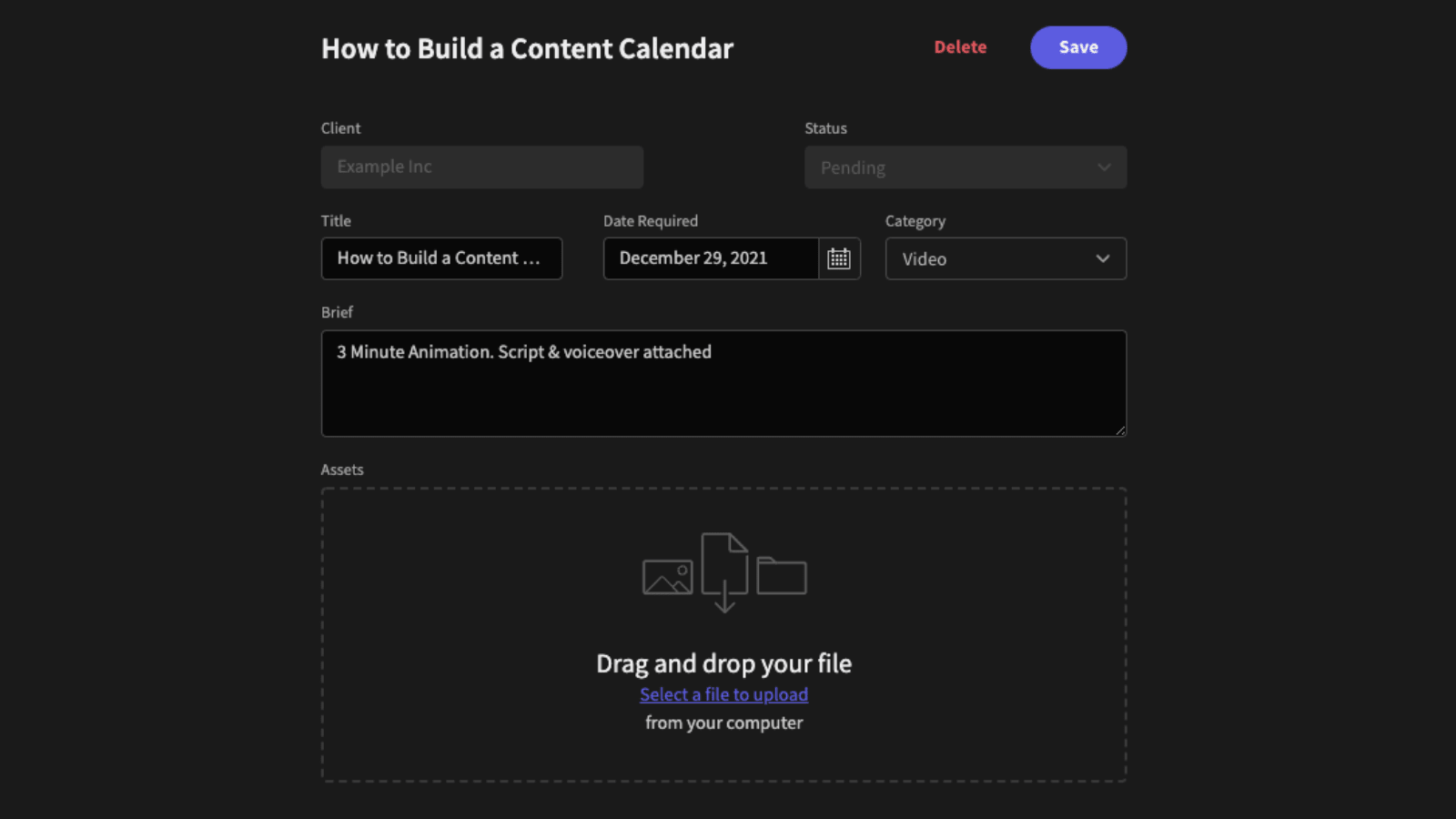
8. Approvals and internal processes
Marketing departments tend to have complex organizational structures. Normally, you’ll have several highly specialized creatives, technical team members, admin staff, project managers, and strategists.
Then you might also have external stakeholders, like freelancers, consultants, and even clients in an agency environment.
This means that roles and responsibilities can be fairly dispersed.
As such, there’s an outsized need for robust internal processes, especially for approvals.
For instance, project initiations, final sign-off, financial approvals, invoicing, and other requests.
Approvals and other internal admin processes can quickly eat up large amounts of your team’s time. Therefore, they’re clear priorities for automation.
This can involve building dedicated approval apps , setting automation rules so that human users only need to review certain requests, and using instant notifications to notify employees when something needs their attention.
Off-the-shelf vs custom solutions
So much about the theory.
Let’s think about the practical side of automating marketing processes. The first thing to understand is that some processes require more front-loaded labor to automate than others.
One factor here is whether or not a solution already exists for your desired use case.
For example, it’s easy to use an off-the-shelf tool for common tasks, like sending automated emails or scheduling social posts.
You’re unlikely to have this option for more tailored processes, such as campaign-specific, cross-channel analytics, or internal processes that closely map your team structure.
In these cases, we’d need to look towards custom solutions.
We’ll cover the specific tools you can leverage to build these in a second. First, though, we need to make a few quick points about custom builds more generally.
For a start, this is obviously going to have an impact on your cost/benefit calculation. However, this might not be as straightforward as you’d think.
You’d probably assume that custom solutions are more expensive, so you’d need to stand to gain more through automation to see ROI.
This can be true, but it isn’t always true.
For example, you might want to manage a very specific element of a process. If the only suitable off-the-shelf tool offers a raft of additional functionality that you don’t need, it might not be worth paying a correspondingly high license fee.
It might be more profitable to opt for a custom micro tool.
Or, you might have more specific needs around privacy, compliance, or integrations that off-the-shelf tools can’t deliver. As such, these would never provide ROI, since they just don’t do what you need.
With that in mind, let’s begin to think about the different kinds of tools that are out there.
Marketing automation tools
Obviously, we’re not going to try and list every automation tool under the sun. Nowadays, marketers have countless platforms to choose from. It can often feel like there’s an SaaS tool for every possible business function.
Instead, it’s worth thinking about the broad categories of tools you can choose from and the decision points that come along with each.
Here we go.
Full-stack tools
These are platforms that aim to be all things to all marketers. Think HubSpot or ActiveCampaign. Normally, they’re kind of suped-up CRM platforms, with additional features aimed at automating specific marketing tasks and processes.
For example, you might also be able to send mass emails, build sign-up forms, or even manage ecommerce sales within a single platform.
There are some obvious advantages to this approach.
For one thing, you’ll have a high degree of cross-channel functionality, right out of the box.
For another, you might already be paying for one of these platforms, so the direct cost of building automations will be particularly low.
There are downsides here too though.
Cost is a huge factor, of course.
That is, full-stack tools aren’t cheap. You also run the risk of getting locked into a particular vendor, as you become dependent on a single platform for so many aspects of your marketing operations.
Again, this won’t be great value for money if you only need specific features.
Check out our guide to operations automation.
Besides this, there’s the fact that individual features might offer less specific functionality than a similar dedicated platform.
Of course, this is only a problem if you need relevant functions.
Process-specific automation platforms
One alternative is using tools with more tightly focused feature sets. These are SaaS tools that are built for very specific functions. For example, you might have a single-function tool for automating a single task, like sharing resources.
Of course, we can’t speak to the quality of every single SaaS platform.
Generally speaking though, we can assume that a dedicated tool is going to outperform a more general platform, or at least offer some differentiating functionality.
This isn’t always the case, but it’s a good rule of thumb.
It’s also worth considering how dedicated tools play into your cost/benefit calculation. The trouble is, this is highly contextual. We saw earlier that jack-of-all-trades tools don’t represent good value if you only need a small subset of their functionality.
As you could probably guess, single-function tools are a better alternative here.
However, this can quickly be undermined if you start adding more dedicated tools to your software stack for other tasks.
When this gets out of hand, things can get expensive.
As such, it’s vital that you thoroughly analyze your present and future needs to figure out what the most cost-effective strategy is going to be.
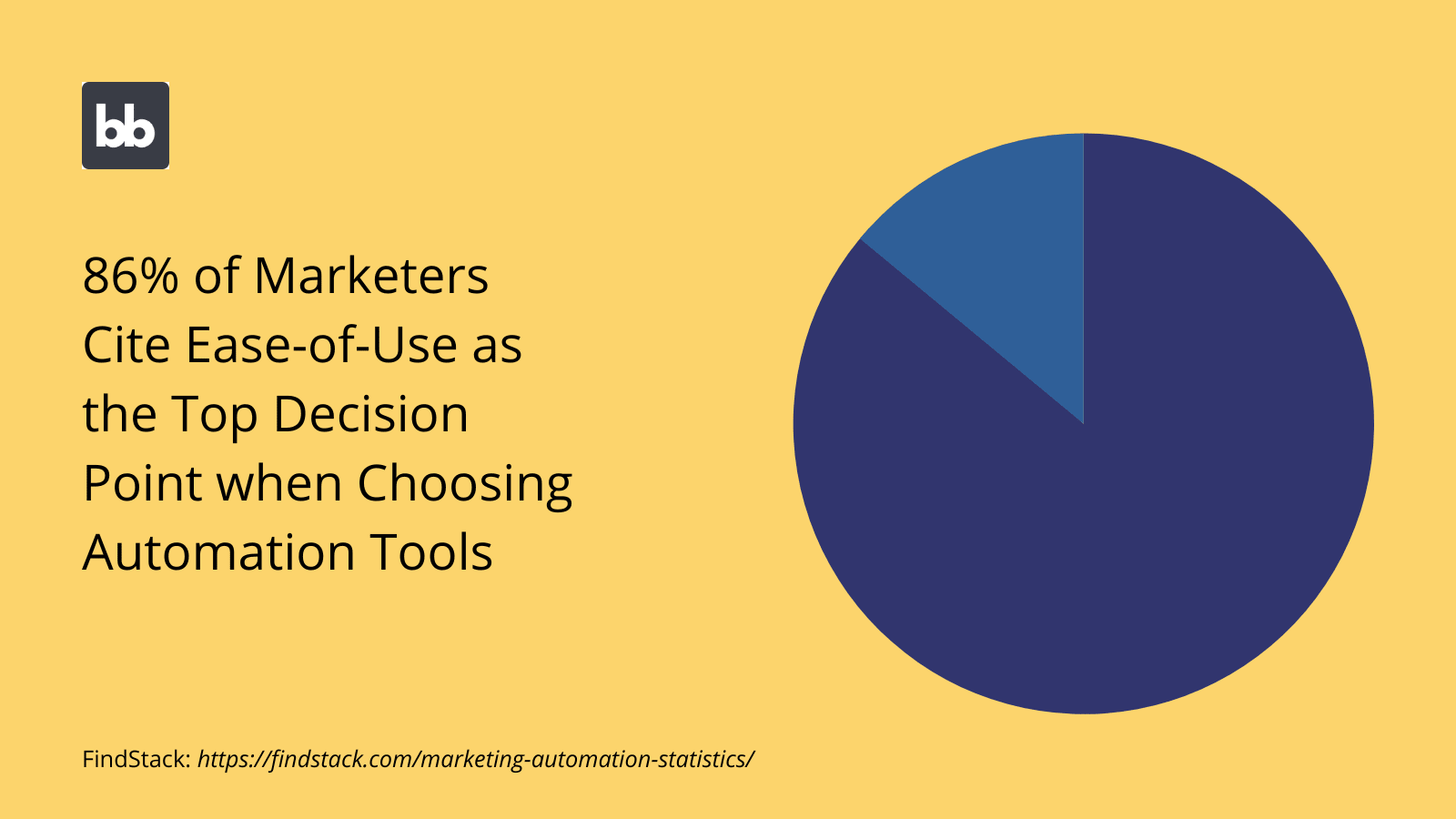
Low-code for marketing automation
As we mentioned earlier, the alternative to using off-the-shelf solutions is to create your own tools for automating marketing processes.
The trouble is, most marketers don’t know how to code, and getting somebody else to do it for you is expensive.
At least, this has always been the case for traditional, slow-code development.
Nowadays, the picture is quite different.
With low-code development, building custom tools to automate processes has never been easier. In fact, with our low-code platform, you can build bespoke automations in as little as five minutes, with zero coding skills.
We’ll look at how this works in Budibase in a little bit more detail shortly.
For now, though, the key thing to understand is the business case for low-code automation.
Essentially, the idea is that we can achieve the same results as custom, hard-coded solutions, with a fraction of the expense and lead times.
This can also work out considerably cheaper than relying on off-the-shelf solutions, especially over the longer term.
Automating marketing processes with Budibase in 5 steps
To see just how achievable this is, let’s take a look at the steps you can follow to automate marketing processes in Budibase.
Again, Budibase is a low-code platform. This means that you don’t need to know how to code to build your own custom tools, but if you do, you can use this to add extra flair and functionality if you want to.
1. Decide what you want to automate
The first step is naturally to decide on the specific tools and processes that you want to automate. We can also take this opportunity to set goals for our project. To find out more about this, check out our ultimate guide to business process automation.
Remember, we have four different kinds of marketing processes that we might want to automate:
- Creative.
- Strategic.
- Operational.
- Delivery.
One point that’s worth making is that low-code development can play a role in any of these, but that it’s most tightly suited to automating operational and delivery processes.
For example, internal processes, project approvals, and actions triggered in or by external tools.
Depending on the scope and ambition of your project, you might want to focus on a specific process or task. Alternatively, you might want to build a tool to manage a range of related processes and tasks, especially where these relate to the same data set.
2. Define your data model
Next, we need to create a data model for our automation tool. This is the first stage of any app-building project. Building a data model means answering a few basic questions:
- What variables will my automation handle?
- What form will these take?
- Where will data be stored?
- How will I connect my data to business processes?
First, we need to answer these questions in abstract terms. Then we’ll move on to fleshing out the more technical details. So, we’d start with listing the attributes we’re going to need.
For instance, we may want to build a simple automation to keep our customers’ contact detail up to date across a couple of different tools. So, all we’d need to do here is list the attributes that both sources share.
We’d then need to think about specific formatting needs in each of these and decide whether we want to designate one as the master version or create an entirely new master source.
In Budibase, this could mean using our internal database, or dedicated connectors for a range of external sources, including SQL, CouchDB, Oracle, MongoDB, REST API, and more.
Check out our in-depth guide on how to create a data model to find out more.
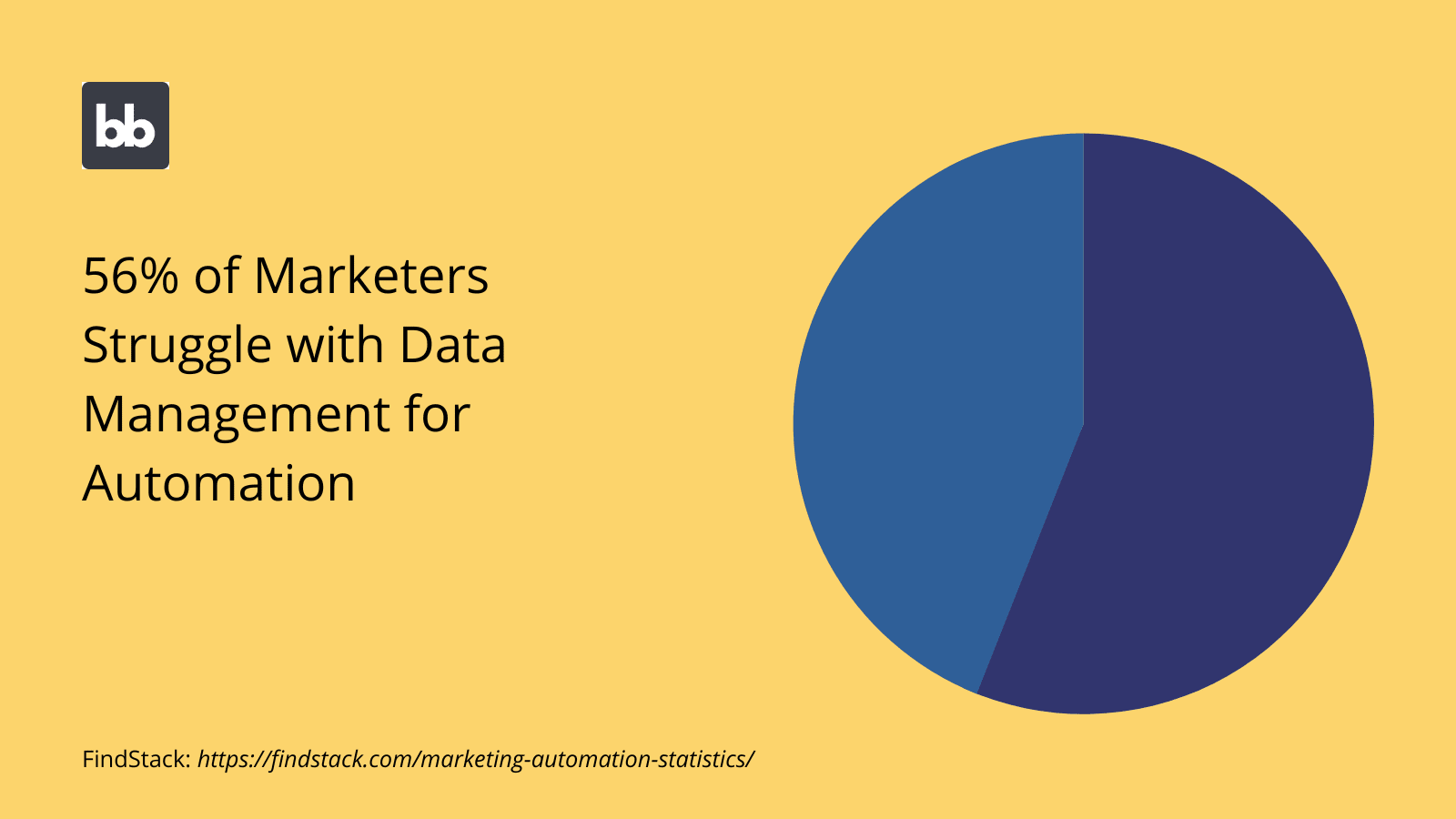
3. Create business processes
With an effective data model in place, it’s time to flesh out how our automations will actually work. This means creating what’s known as a business process layer for our application. This is where we define and apply logic to our data.
As we saw earlier, an automated process basically has two components, a trigger, and an action.
In other words, we define a condition, along with an instruction to carry out a defined action when this is met.
WIthin Budibase, there are a couple of distinct ways to build out your business process layer.
The first is creating formula variables within your data model, using either JavaScript or Handlebars expressions. This is useful for carrying out simple tasks, like categorizing database entries or updating their status as processes progress.
Alternatively, for more advanced processes, you can use our dedicated automation builder.
Here you can access, nest, and configure a wide range of built-in automation actions. Use everything from simple database queries to custom JavaScript blocks. We also offer looping, conditionality rules, and bindable values for complete flexibility.
Our automation rules are triggerable by user actions, system events, temporal rules, or back-end data conditions.
Finally, to really supercharge your marketing process automations, you can introduce third-party platform integrations as both triggers and actions.
This works by using incoming and outgoing Webhooks within your automation rules.
So, you might build a lead generation form in Budibase, and then use a sign-up event to trigger a defined action in an external tool. This could be as simple as adding the same data to your CRM tool.
Alternatively, you might use an external trigger to initiate a process that you’ve created in your Budibase tool. For example, a new sale in your ecommerce platform could be used to trigger your custom automation rules.
4. Build interfaces
With your business processes defined, it’s time to start building your app interfaces. Marketers tend to have a good grasp of the basic principles of design, but they typically don’t have the technical skills to put these into practice.
Budibase has you covered here.
We offer a whole suite of user-friendly tools, for creating professional app UI designs , in seconds.
Once you’ve connected your desired data source, you can use autogenerated screens to create a fully functioning CRUD app , at the press of a button. We also offer a huge range of configurable, pre-built components and blocks, to fully customize your designs.
Use advanced features like custom CSS, conditionality rules, and mobile optimization to build the perfect UIs to automate your marketing processes.
5. Launch your tools
Finally, it’s time to launch your new automated platform. Again, Budibase can be as simple or as sophisticated as you need it to be here. We offer instant cloud-based deployments, on our proprietary Budibase Cloud platform.
We’re biased, but we don’t think there’s a faster or easier way to deploy web apps.
Budibase also offers self-hosting, using Kubernetes, Docker, Docker Compose, and Digital Ocean. Host your tools on your own infrastructure for complete security, flexibility, and control.
Example: How to automate your sign-up forms
Maybe this all sounds too good to be true.
To prove just how easy it is to automate your marketing processes in Budibase, let’s take a few tasks as examples. We’re going to be basing this on our multi-step lead generation form , which you can use for free when you sign up to Budibase.
As a bit of background, this is a simple signup form, where users can add the following details:
- Name.
- Email.
- Company.
- Company size.
- Phone number.
- Role.
- Department.
- Notes.
Specifically, we’re going to create three automations. Let’s take a look at each in turn.
1. Route enterprise leads to a dedicated team
First, we want to make sure our enterprise leads are sent to our top sales professionals, so they can get the celebrity treatment. To do this, we’ll head over to the Automations tab in Budibase, and create a rule called Send to enterprise team.
We’ll trigger this any time a row is created:
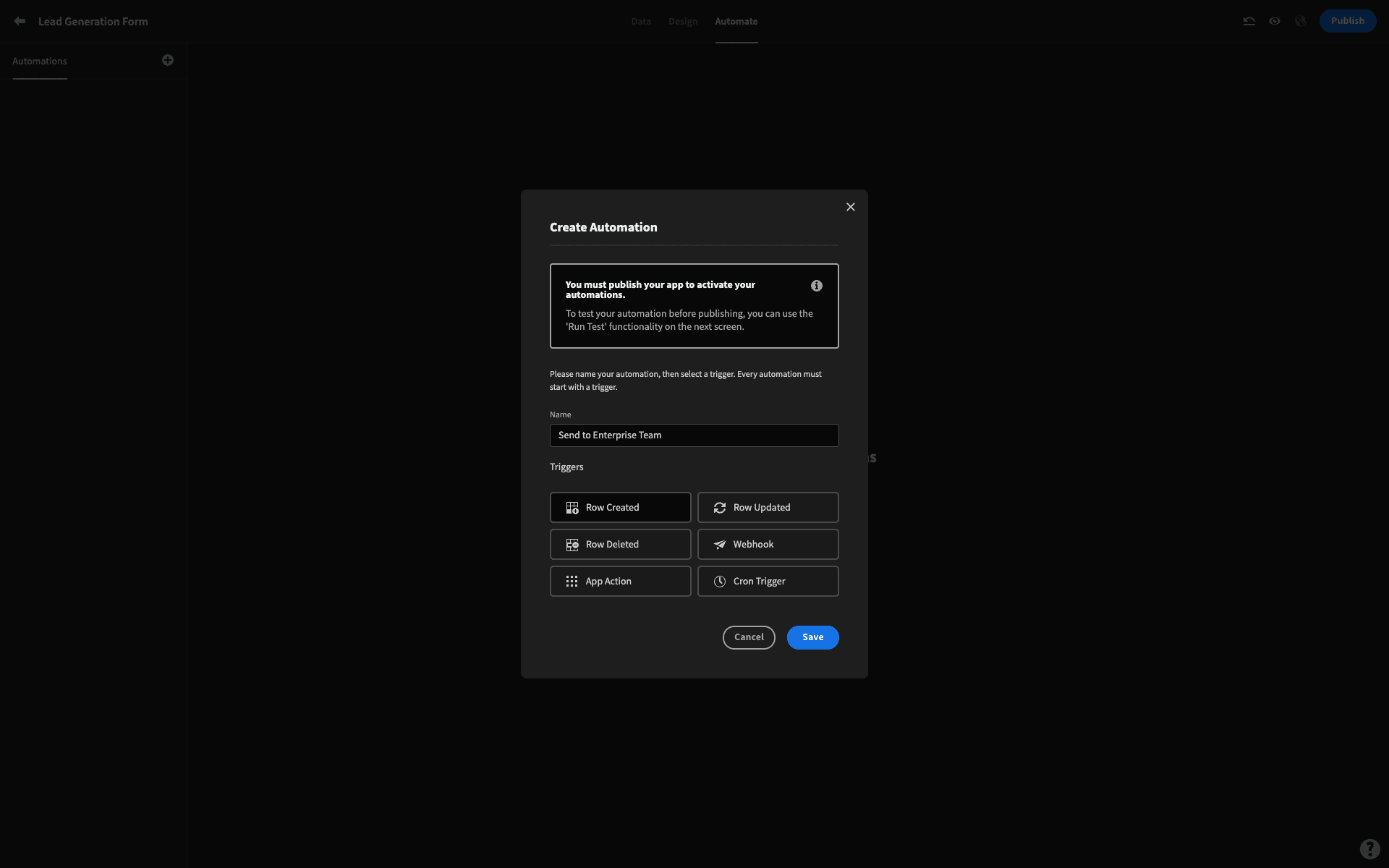
Next, we’ll add a condition, to check whether the company size is over 10,000:

To do this, we’ve used JavaScript to bind the reference value to the company size attribute of the row that’s just been created, using the following expression:
return $("trigger.row.Company size");
Note that our template doesn’t ask leads to give us an exact figure for their employee count. Instead, it’s an enumerator value, where one of the options is the string ‘10000 +’. If we had a numerical value, we’d need to use a greater than condition.
Finally, we can use Zapier to send the values from our new row to whichever external platform or database our enterprise sales team uses:

All we need to do is designate the relevant Webhook URL, and bind the trigger row as our payload value. We’d then extract the specific values we need in the target platform.
2. Sending welcome emails
Our non-enterprises aren’t going to get a personal response. Instead, we’ll use Budibase’s built-in email automations to welcome them, and send any resources we’ve used as a lead magnet.
We’ll start by repeating the first two steps we used before, except this time we’ll set our condition to only carry on the automation for companies with less than 10,000 employees. Since it’s an enumerator, the condition is Company Size doesn’t equal ‘10000 +’.
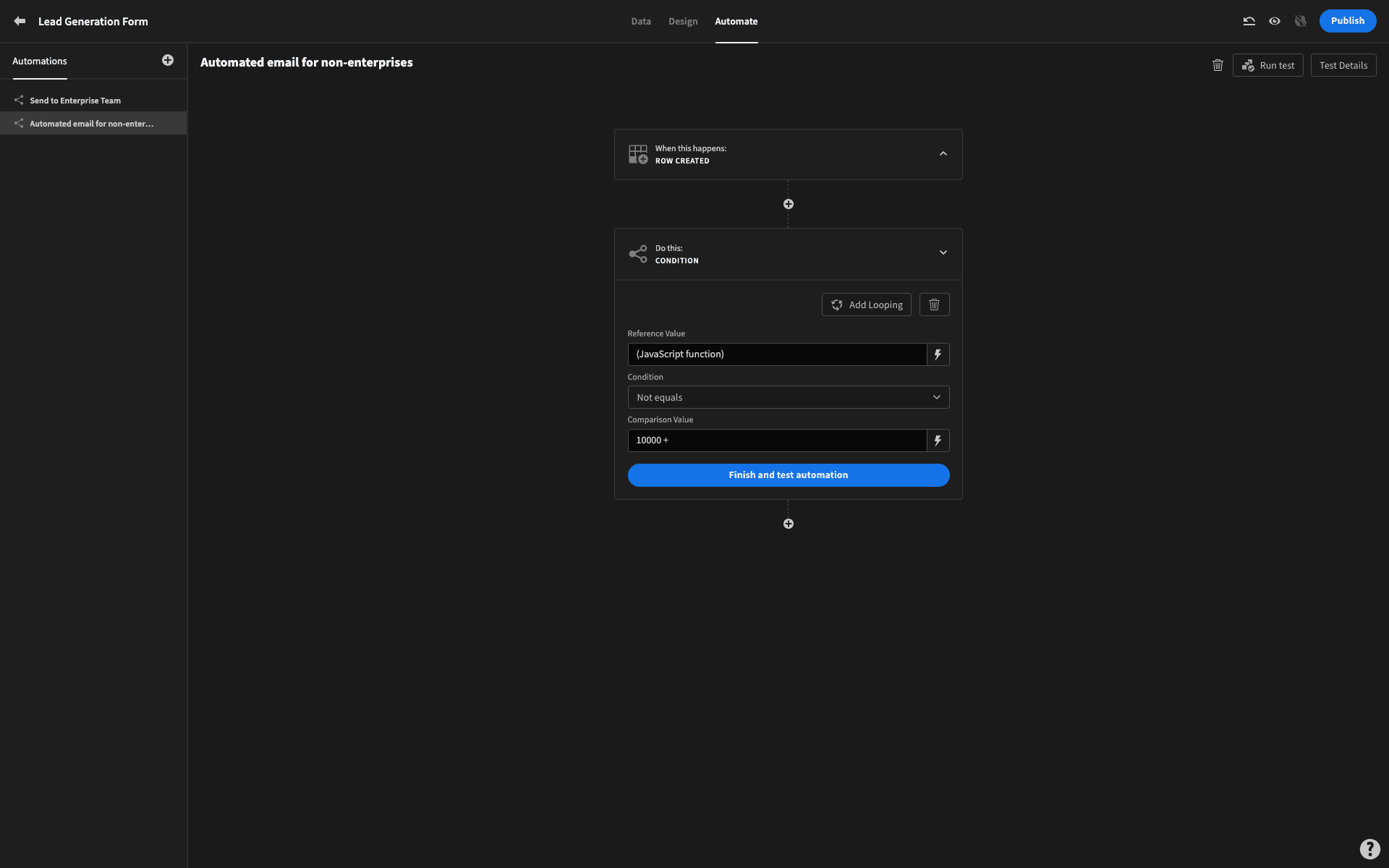
Next, we’re going to head over to the Budibase Account Portal and set up our SMTP credentials, so we can send email automation:

Then we can create simple HTML-based email templates, which can be populated with bindable user attributes:
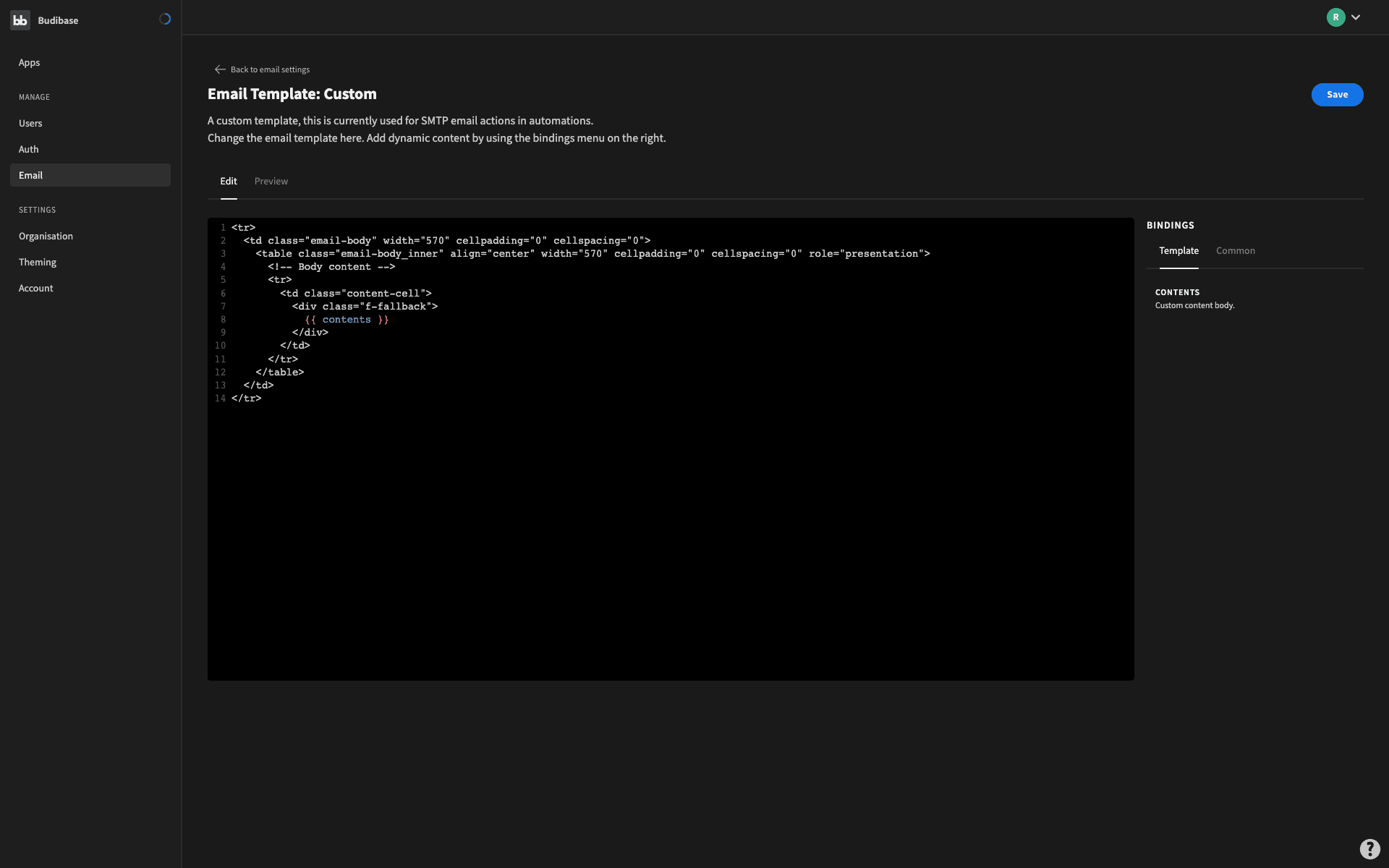
These can then be called as the final step of our automation. Check out our documentation on sending emails from Budibase for more information.
3. Updating status with external trigger
Finally, let’s try using an external trigger to update the status of our leads. For the sake of this example, we’ll create a simple Status attribute, which can be set to either Hot or Cold, by defined triggers.
Then, we’ll create a new automation called Change Status, that’s triggered by an external Webhook:

This gives you a URL that you can paste into your external platform, as the target destination:
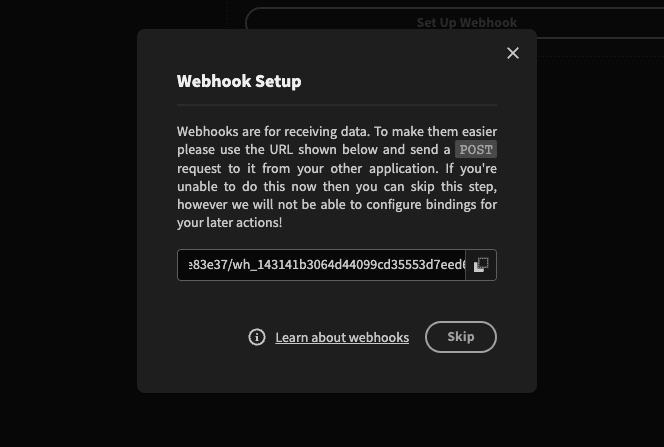
What needs to happen in the external platform to send this Webhook is up to you.
Then, we’ll add a query rows block, and create a filtering rule to isolate the row in our internal table which matches the primary display of the object sent through the Webhook:

Let’s assume that the Webhook only gets sent my the external platform when someone opens one of our marketing emails. Next, we need to add an update row block, to change the status to Hot for the output row of the previous step:
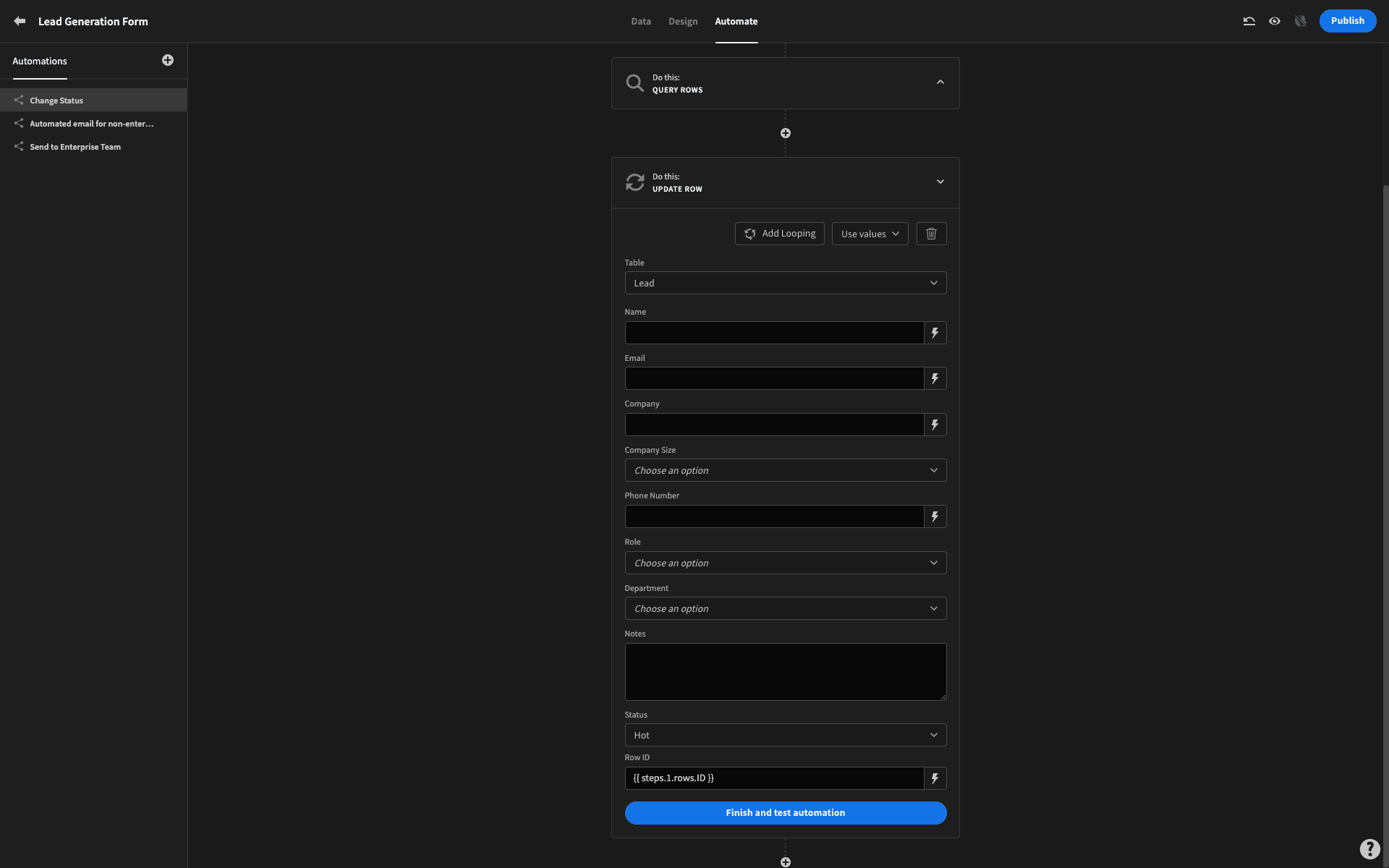
If we want, we could also create an almost identical automation rule with a new Webhook that’s triggered by an external action that tells us a lead has gone cold. For example, if they’ve failed to open ten emails in a row.
Budibase for sales and marketing teams
At Budibase, our mission is to transform the way businesses build custom tools. A huge part of this is democratizing the way we solve problems. This means empowering sales and marketing teams to build incredible tools, without shelling out for traditional developments.
We offer a range of intuitive tools that make Budibase the smart choice for citizen development.
From autogenerated CRUD screens and external data connectors to third-party integrations and our custom automation builder, Budibase is the ideal solution for all kinds of sales and marketing problems.
We’ve even created 50+ free app templates to help you get started.
Sign up to Budibase today to start building professional applications for free.